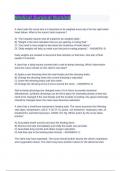Tentamen (uitwerkingen)
Chapter 42: Lower Gastrointestinal Problems Lewis: Medical-Surgical Nursing, 10th Edition A 22-yr-old female patient with an exacerbation of ulcerative colitis is having 15 to 20 stools daily and has excoriated perianal skin. Which patient behavior indi
- Vak
- Instelling
Chapter 42: Lower Gastrointestinal Problems Lewis: Medical-Surgical Nursing, 10th Edition A 22-yr-old female patient with an exacerbation of ulcerative colitis is having 15 to 20 stools daily and has excoriated perianal skin. Which patient behavior indicates that teaching regarding maintenance...
[Meer zien]




